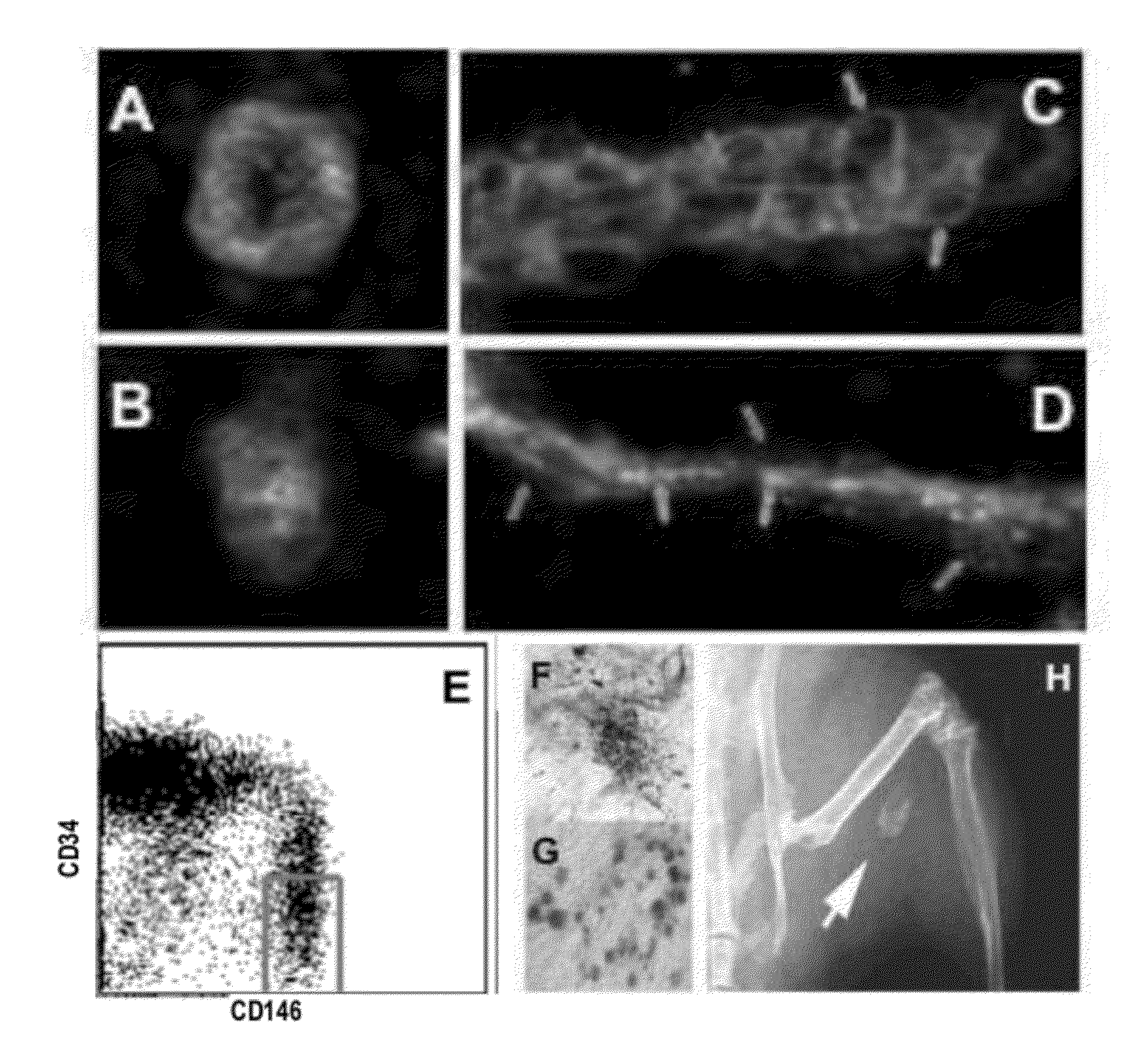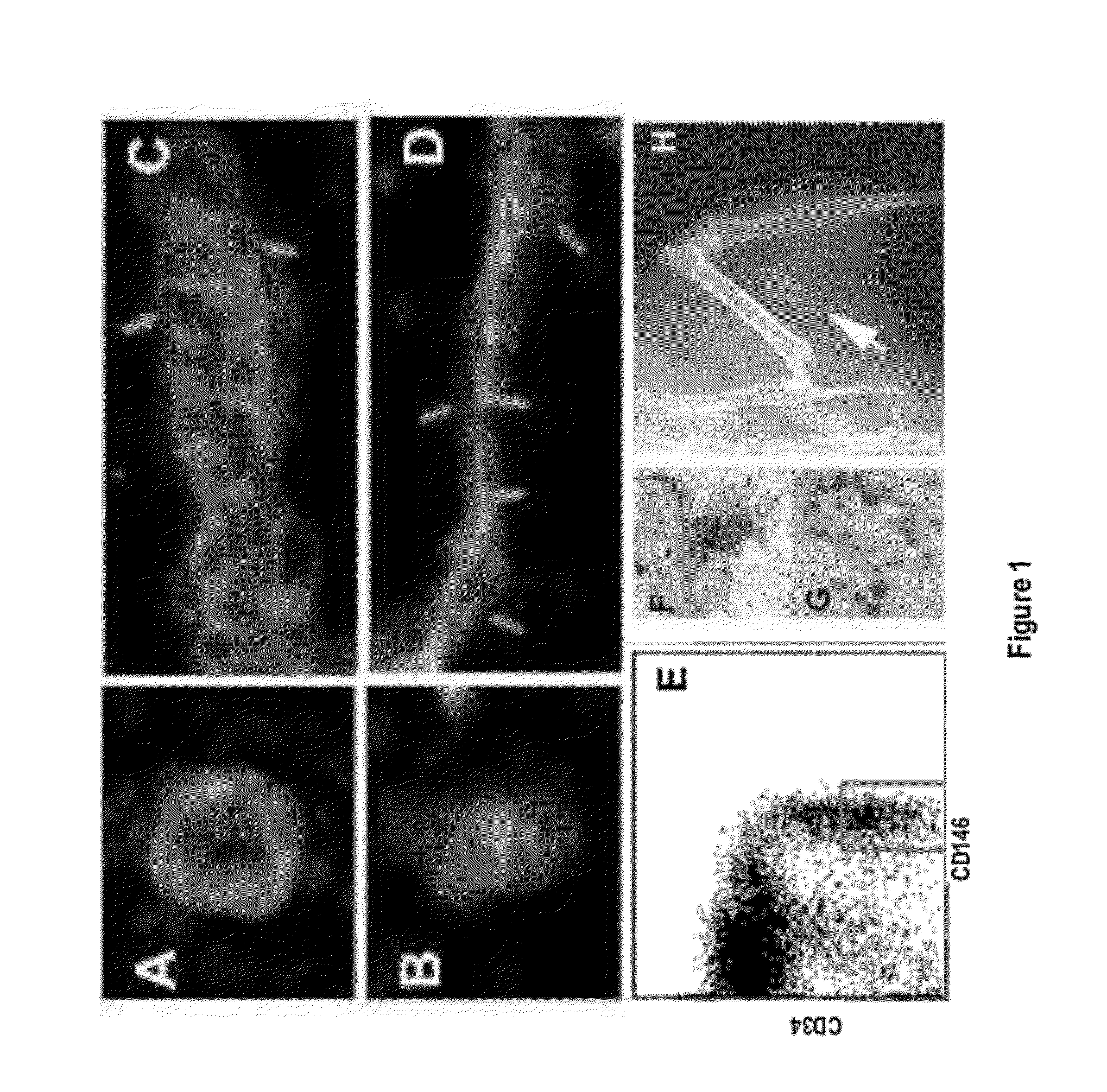Perivascular Stem Cell Composition For Bone
a technology of perivascular stem cells and bone, which is applied in the direction of drug compositions, peptide/protein ingredients, biocide, etc., can solve the problems of reduced stem cell availability and activity in the bone marrow, complete pelvic ring failure, and increased blood loss, so as to enhance the survivability or engraftment of psc, enhance vascular ingrowth, and treat, delay or ameliorate a bone condition
- Summary
- Abstract
- Description
- Claims
- Application Information
AI Technical Summary
Benefits of technology
Problems solved by technology
Method used
Image
Examples
example 1
Studies on PSC+NELL-1 Composition for Osteogenesis
General Methods
[0153]In vitro efficacy is evaluated by trophic factor production and osteogenic differentiation; in vitro safety by genetic stability; in vivo efficacy and safety by imaging, surgical pathology, histology, immunohistochemistry, and cell tracking studies.
[0154]Note, as used in the examples, the terms “optimized” or “opt” are used to designate an embodiment or embodiments that achieves a better result or results under given conditions. These terms shall in no way be construed as the preferred embodiments or best modes of the present invention.
Discussions
[0155]In the studies described herein, we have developed an adult, perivascular stem cell based PSC+NELL-1 combination product that exceeds the efficacy and safety of current bone regeneration therapies. The studies show that when combined with NELL-1, adipose derived PSC are a safer and more efficacious stem cell to use for bone regeneration.
[0156]We have marked and pur...
example 2
Isolation of Adventitia PSC from Liposuction Aspirate
[0187]SVF Isolation from Liposuction Aspirate.
[0188]Liposuction aspirate was washed with an equal volume of PBS and centrifuged for 10 minutes at 400×g. After centrifugation, the top layer of the preparation, representing the tissue fraction containing the SVF, was collected and further washed in PBS. The tissue fraction was then enzymatically processed by addition of an equal volume of digestion solution (DMEM, collagenase II 1 mg / ml, DNAse 10 μg / ml, 1% Pen-Strepto, 3% BSA) and incubation for 45 minutes at 37 C under agitation (250 rpm). The enzymatic digestion was stopped after addition of PBS 5 mM EDTA and the solution was filtered through 100 μm cell strainer. After two washes in PBS 5 mM EDTA and centrifugation at 400×g for 10 minutes, the supernatant containing adipocytes was discarded and the pellet was resuspended in 10 ml red blood cell lysis buffer for 10 minutes at room temperature. The suspension was washed in PBS 5 mM...
example 3
Osteogenic Studies on Pericytes and NELL-1
[0191]Experiments on osteogenic ability of pericytes and NELL-1 factor were performed in a SCID mouse thigh muscle implantation model. The results are shown in FIGS. 12 and 13. FIG. 12 shows increased pericyte proliferation / survival when Nell-1 is added. FIG. 13 shows increased VEGF expression by pericytes when Nell-1 is added.
[0192]The above results clearly documented the osteogenic ability of pericytes and NELL-1. These experiments demonstrate the effects of NELL-1 for enhancing survivability and engraftment of PSC or iPS and for causing PSC or iPS to differentiate into osteoblasts or progenitor cell lineage so as to generate a bone tissue.
PUM
| Property | Measurement | Unit |
|---|---|---|
| total volume | aaaaa | aaaaa |
| volumes | aaaaa | aaaaa |
| volumes | aaaaa | aaaaa |
Abstract
Description
Claims
Application Information
 Login to View More
Login to View More - R&D
- Intellectual Property
- Life Sciences
- Materials
- Tech Scout
- Unparalleled Data Quality
- Higher Quality Content
- 60% Fewer Hallucinations
Browse by: Latest US Patents, China's latest patents, Technical Efficacy Thesaurus, Application Domain, Technology Topic, Popular Technical Reports.
© 2025 PatSnap. All rights reserved.Legal|Privacy policy|Modern Slavery Act Transparency Statement|Sitemap|About US| Contact US: help@patsnap.com



